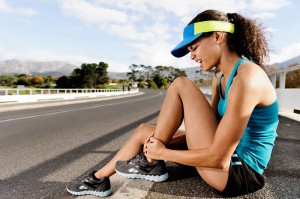”Shin Splints” – Which Type Have You ?
 ”Shin splints” is a catch-all term for shin pain either on the front outside part of the lower leg (anterior shin splints) or on the inside of the lower leg (medial shin splints). It is the curse of many athletes including runners, tennis players, dancers etc. Frequently the condition plagues novice runners who do not build their mileage gradually enough. It also affects seasoned runners who abruptly change their workout regimen, suddenly adding too much mileage, or switching from running on the flat to hills. The term mainly refers mainly to the following three conditions 1. mini stress fractures within the tibia bone, 2. chronic exertional compartment syndrome, 3. medial tibial stress syndrome. It is important to differentiate between the three for treatment.
”Shin splints” is a catch-all term for shin pain either on the front outside part of the lower leg (anterior shin splints) or on the inside of the lower leg (medial shin splints). It is the curse of many athletes including runners, tennis players, dancers etc. Frequently the condition plagues novice runners who do not build their mileage gradually enough. It also affects seasoned runners who abruptly change their workout regimen, suddenly adding too much mileage, or switching from running on the flat to hills. The term mainly refers mainly to the following three conditions 1. mini stress fractures within the tibia bone, 2. chronic exertional compartment syndrome, 3. medial tibial stress syndrome. It is important to differentiate between the three for treatment.
1. Real ”shin splints”
Real ”shin splints” are mini stress fractures (splint-ers) within the tibia bone. With this condition pain is gradual in onset, getting worse with activity, and there is usually a history of an increase in training intensity. Pain may occur with walking, at rest, or even at night in bed. Treatment for this condition involves rest for about eight weeks from running to allow the little stress fractures to heal. You should be able to keep up fitness levels by cycling, swimming etc., as these exercises are low impact. You may need to look at lower limb biomechanics, running style, training practices etc. to prevent recurrence of the shin splints .
2. Shin splints – Chronic exertional compartment syndrome
Chronic exertional compartment syndrome is defined as increased pressure within a closed fibro-osseous space(like the space the tibia and fibula), causing reduced blood flow and tissue perfusion(perfusion is the process of a body delivering blood to a capillary bed in its biological tissue), which subsequently leads to ischemic pain(pain due to restriction of blood supply, and thus oxygen and nutrients to tissue) and possible permanent damage to tissues of the compartment. The syndrome is frequently bilateral (both legs). Typical features of the condition are absence of pain at rest, with increasingly achy pain and a sensation of tightness in the shins upon exertion. Symptoms usually resolve or significantly dissipate within several minutes of resting. Anyone can develop the condition, but it is more common in athletes who participate in activities that involve repetitive impact, such as running. Sometimes Chronic exertional compartment syndrome may respond to deep tissue work and myofascial release of the structures involved. Changing your chosen activity to one involving less impact may also help. Surgery may be used as a last resort to relieve the pressure. It involves operating on the inelastic tissue encasing each muscle compartment (fascia). Methods include either cutting open the fascia of each affected compartment (fasciotomy) or actually removing part of the fascia (fasciectomy).
Shin splints – Medial tibial stress syndrome
Medial tibial stress syndrome is an inflammation of the muscles, tendons, and bone tissue around your tibia. A common cause of Medial Tibial Stress Syndrome is pes planus (flat feet) or over-pronation of the foot during running. This puts increased strain on the Tibialis Posterior and soleus muscles leading to chronic traction at their insertions onto the periosteum on the posterior inner border of the tibia, producing pain in this area. Mild swelling in the area may also occur. The pain may be sharp and razor-like or dull and throbbing, occurring both during and after exercise, and aggravated by touching the sore spot. Initial treatment involves rest, ice, analgesics. Again switching to low impact activities such as swimming or cycling can keep a sports person active during recovery. For treatment, the entire calf should be assessed. The use of myofascial release techniques along with proper hands-on deep tissue work concentrating on thickened muscle fibres of the soleus, flexor digitorum longus and tibialis posterior adjacent to their bony attachments can prove effective. Dry needling and electro-acupuncture can also benefit recovery. Arch supporting orthotic insoles designed to reduce impact forces, correct flat-footedness and overpronation during running can help prevent recurrence and facilitate recovery by offloading affected structures. For some more information click here.